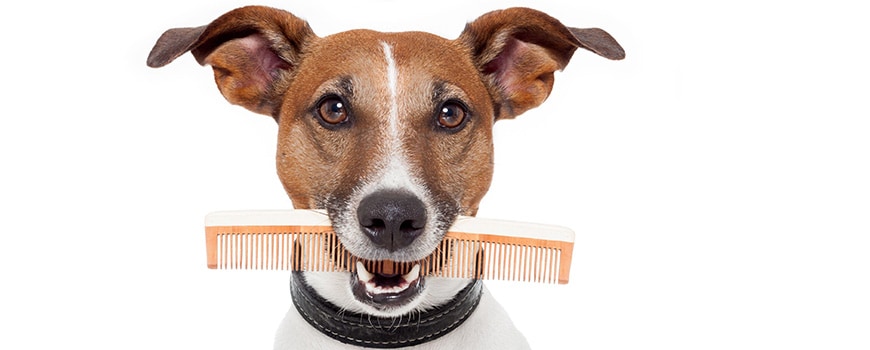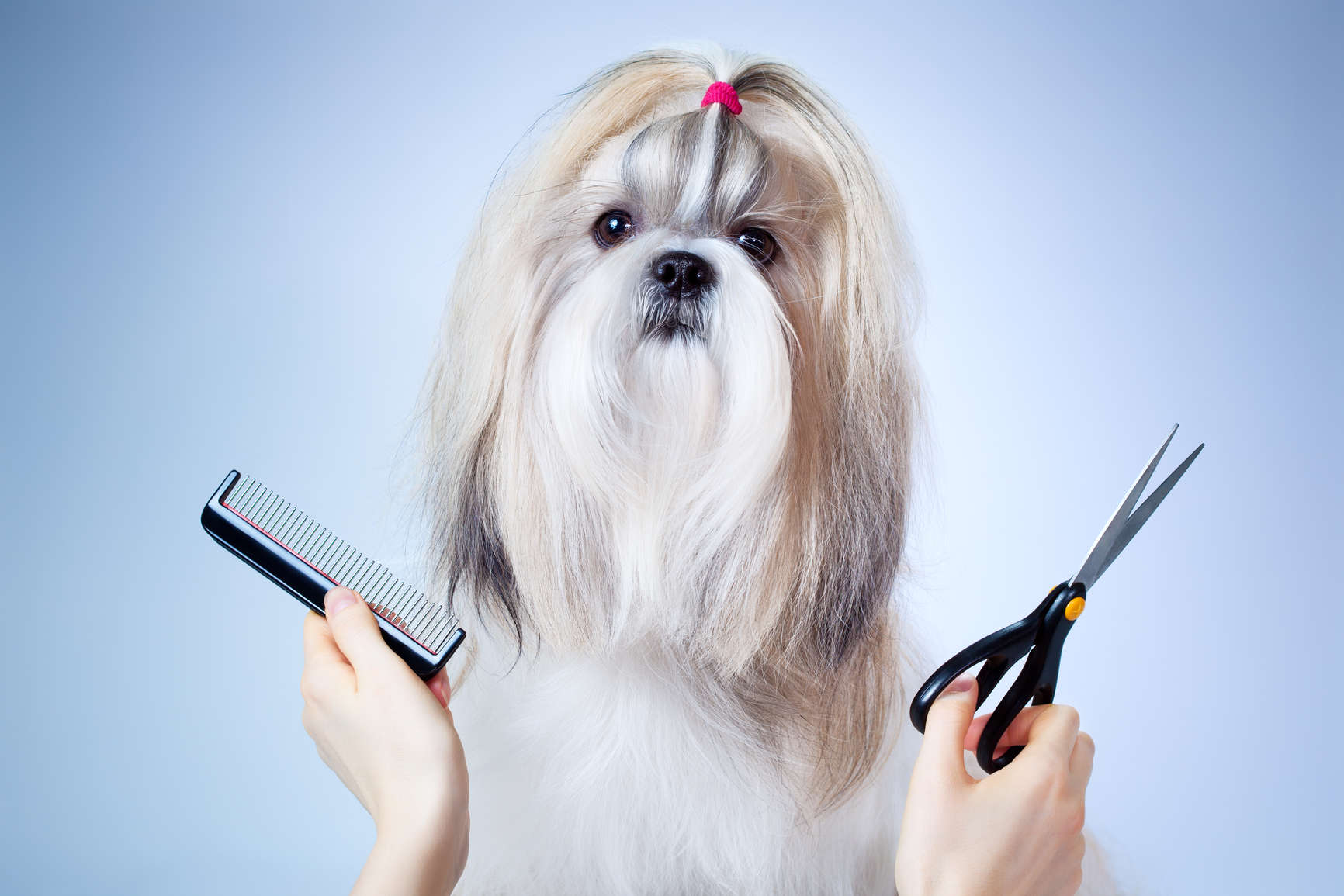Here’s some of the most common dog grooming difficulties what many groomers experience when handling dogs. To avoid these difficulties, get your dog to get used to being handled and groomed from an early age. Some groomers have been trained to trim, but they haven’t necessarily had sufficient experience with dogs to understand fully why they act – or react – the way they do. A “doggie” background really helps – and working with dogs every day soon provides plenty of experience.
HANDLING SKILLS
Many groomers have asked me for advice on how to cope with vicious dogs. Nasty dogs that cannot be trimmed on their first visit to the groomer are extremely rare. It is usually only nerves that cause them to react irrationally. An experienced groomer soon learns how to put a dog at ease.
The secret of success is to put the dog’s welfare above the finish of a trim. This is certainly top of my list of priorities. Yes, I like a dog to look good when it walks away from my door, but I also like a happy dog that wags its tail when it sees me — rather than cowering or putting its tail between its legs. I will sacrifice a degree of presentation in order to achieve this. After a few visits, the dog will become increasingly confident about being groomed, and you will be able to groom it as you would any other dog.
Pet dogs who constantly have children and visitors around them are usually extremely cooperative, providing there is an incentive —a treat at the end of the session, a pat or a kind word.
DEALING WITH DIFFICULT DOGS
Unfortunately, through lack of time, skill or understanding, some groomers can make a dog react in a defensive way, which then means the dog is labeled as nasty. The only thing to blame here is the groomer’s lack of training or experience. A spoiled brat of a dog is sometimes awkward to begin with, but dogs hate being ignored, so if you don’t say much to them and don’t take on their owners’ “baby talk,” the dogs soon pester you for attention.
Some dogs, who have been mistreated or misunderstood, will be difficult to trim for four or five visits to an experienced, flexible and well-trained groomer. Then they suddenly become angels. This is common, far more common than the dog that can’t be won round by patience and kind handling.
Dogs with arthritis or puppies with growing pains should have their situation assessed and taken into consideration. Again, experience and good training allows the groomer to recognize these problems and act accordingly.
Dogs bite through self-defense and because they are worried or scared and feel vulnerable. Act confidently, treating the dog with respect and kindness at all times. If a dog is nervous, talk to it to reassure it. Some dogs are aggressive because they consider themselves to be dominant over people. With such cases, the owner should enrole the dog at a good obedience class or seek specialist behavioral advice.
A new groomer, a lady with three weeks training, proudly told me how she had fought with a 7-month-old Standard Poodle
for more than an hour to clean the hair from its ears. I despair. Why put any dog through this sort of trauma? Trimming dogs is not a battle of strength or wits. If this lady had been a hairdresser and the dog a child, would she have still fought hand and fist with him? Most dogs are far more ready to please you than children are. If you tie them up by neck and stomach, put a muzzle on them and fight them until they’re subservient, what can you expect other than trouble?
DOGS WITH CLIPPER PHOBIAS
Electric clippers are greatly feared by some dogs. Why is it that a dog that is pleased to see you will sit on a table and be brushed, yet, the minute the clippers are turned on, it leaps six feet in the air? Stop. Think. Why is the objection so acute?
- Does the dog have arthritis, which is fairly common, or some other bone or growth pain abnormality? If so, take this into account when handling the dog. For example, infected mouths with sore abscessed teeth and gums will cause some dogs to fight a clipper on their face due to pain.
- Has the dog been burned with hot clippers in the past? It is a good idea to use cool, lubricating clipper spray every five to 10 minutes to keep the blade free-running and cool. Test the blade on your own face every so often.
- Has the dog, perhaps even at the age of a few years old, never had a pair of clippers near it? If this is the case, the dog will need to be introduced to the sight, smell and sound of the clippers in a calm, controlled way. Have the clippers running nearby while brushing the dog so it gradually gets used to the sound. Only when the dog is comfortable with having the clippers nearby should you attempt to use them.
Most of the problems that occur during trimming can be attributed to lack of consideration by the owner and sometimes the groomer. Sometimes the owner causes the problem when brushing at home. Lack of patience, physically wrestling the dog into submission, hurting the dog without realizing it – these things must be recognized and overcome.
Often, owners tell me that their dog tries to bite them when they attempt to brush it, yet this same dog is as good as gold when it comes to the parlor. It is unlikely that the dog is behaving this way because it is spoiled and belligerent, but rather because the owner inadvertently hurts the dog, scraping his skin with too severe a brush, or twisting the dog’s legs into awkward positions to achieve an objective. A little know-how goes a long way.
FIRST-TIMERS
Most dogs are nervous on their first visit to a new groomer, but they soon settle down, especially when you sing along to the radio or hold a conversation with the dog or somebody else. Your calm voice and casual manner will settle a dog quicker than anything.
Dogs very easily learn to sit, stand and stay on the grooming table without the aid of contraptions. A groomer takes on, as part of the job, the responsibility to teach the dog what is required of it in a calm and caring manner, without fuss and bother. Dogs of most breeds thoroughly enjoy going to the grooming salon. If you have more than your fair share of objecting dogs, then perhaps it is time you took more training or considered another career.
Dogs have teeth that bite. They use them when they are confused, scared or cornered. It comes back to the fact that anyone can trim the hair off a stuffed dog, but it takes a special person to become a good groomer who understands dogs.
SOCIAL SKILLS
One would never believe how much diplomacy counts in the grooming game. Dealing with dogs is much easier than coping with nervous, neurotic, uncaring, b overbearing and supercilious people, but it is all part of being a dog groomer.
Thankfully, on the whole, dog owners care about their dogs (sometimes too much). Only occasionally is there a time when tempers are so frayed that the dog owner gets a good taste of the whipping edge of my tongue. Neglect is one aspect that makes me livid. There is no need for it. There are so many groomers around that there is no need to visit a groomer only once a year, or when the dog is in a disgusting state.
There are occasions when the breeder is at fault, telling the new puppy owner that the dog should not be clipped until it is 6 months old (that’s the story we are frequently told); this usually ends up with the owner leaving the dog until it is a year old. By this time, the coat is looking scruffy and out of control, with accumulated mats.
THE CUSTOMER IS ALWAYS RIGHT
Groomers do, from time to time, fall out with clients, usually because of the neglect of a dog, but sometimes because the groomer wants to trim a dog a certain way and the client prefers the dog all clipped off. It is as well to remember that the customer is always right. This may not be the case, of course, but as a groomer it is your job to give the customer what he or she wants.
Groomers that have a fetish for combing out knots and tangles and turning out a first-class trim may be admirable and deserve recognition, but sometimes it is more appropriate to opt for something simpler and easier to manage.
For example, perhaps the dog leads a lifestyle whereby it is forever getting wet and muddy; perhaps the owner never puts a brush near the coat; or perhaps the owner just wants the dog to have a very short haircut for their own convenience. In such instances, there is nothing wrong with clipping the dog all over with a No. 5 Oster blade.
I know some groomers who will refuse to do this, but I don’t understand why. If the dog is comfortable and the client is happy, where’s the problem? The dog must come first. A matted dog is an unhappy dog. It will be much happier having its hair clipped short than enduring hours of having its mats and snarls ripped through with a brush.
NERVOUS OWNERS
Some owners are reluctant to leave their dogs. I don’t see this as a problem. I invite the owner to stay and watch the proceedings, explaining that some dogs do act up with their owners present, but it won’t bother me if it doesn’t bother them. Once the owner is confident in your ability, they will happily leave the dog in your care.
Some owners are often shocked that I do not possess a muzzle — I never have — and I don’t tie dogs to grooming contraptions or hooks on the wall. Dogs soon learn to sit or stand still and to be groomed, clipped, stripped, whatever. A little training goes a long way.
Putting people and their dogs at their ease is a gift and is incorporated into the training of any good groomer. It may take a bit longer to trim the dog this way for the first couple of visits, but the effort is worthwhile.

